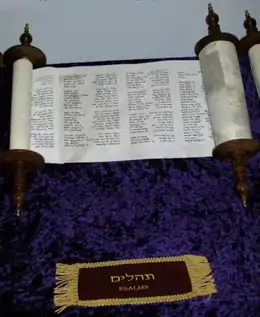Psalm 136
Psalm 136 is the 136th psalm of the biblical Book of Psalms. In the Greek Septuagint version of the bible, and in its Latin translation in the Vulgate, this psalm is Psalm 135 in a slightly different numbering system. It is sometimes referred to as "The Great Hallel".[1]
| Psalm 136 | |
|---|---|
 Scroll of the Psalms | |
| Book | Book of Psalms |
| Hebrew Bible part | Ketuvim |
| Order in the Hebrew part | 1 |
| Category | Sifrei Emet |
| Christian Bible part | Old Testament |
| Order in the Christian part | 19 |
Uses
Judaism
The term Great Hallel (Hallel HaGadol), meaning great praise, is used to refer to Psalm 136. It's called "great" to differentiate it from the Egyptian Hallel, another prayer of praise comprising psalms 113 to 118.[2]
- Is recited in its entirety during the Pesukei Dezimra on Shabbat, Yom Tov, and Hoshana Rabbah.[3]
- Is recited on the eighth day of Passover in some traditions.[4]
- Verse 1 is part of the final paragraph of Birkat Hamazon.[5]
- Verse 4 is recited when opening the Hakafot on Simchat Torah.[6]
- Verse 6 is recited in Rokah Ha'aertz Al Hamayim of Birkat HaShachar.[7]
- Verse 7 is part of Likel Barukh in Blessings before the Shema.[8]
- Verse 25 is part of the opening paragraph of Birkat Hamazon.[9]
Eastern Orthodox
- Along with Psalm 135 (LXX numbers as 134 & 135 respectively) is called the Polyeleos or translated to "Many Mercies", named such after the refrain used "for His mercy endures forever". The Polyeleos is sung at Orthros (Matins) of a Feast Day and at Vigils. In some Slavic traditions and on Mt. Athos it is read every Sunday at Orthros.
- On Mount Athos it is considered one of the most joyful periods of Matins-Liturgy, and the highest point of Matins. In Athonite practice, all the candles are lit, and the chandeliers are made to swing as the Psalms are sung, it is also accompanied by a joyful peal of the bells and censing of the church, sometimes with a hand censer which has many bells on it.
- At vigils, it accompanies the opening of the Royal Doors and a great censing of the nave by the Priest(s) or Deacon(s).
Coptic Orthodox
This Psalm is chanted as the second Canticle or the second Hoos of the Midnight Praises known as Tasbeha, a nightly prayer practiced in Coptic Orthodox Churches and Monasteries.
Musical Settings
Verses 1-15 were set by Roxanna Panufnik as "Love Endureth" in 2012. "Forever", written by Chris Tomlin in 2001, also draws heavily on this Psalm for its lyrics.
References
- Light and Fire of the Baal Shem Tov By Yitzhak Buxbaum, page 399
- "הלל המצרי והלל הגדול בליל הסדר | בית המדרש | שיעורי תורה". אתר ישיבה.
- The Complete Artscroll Siddur page 384
- The Artscroll Tehillim page 329
- The Complete Artscroll Siddur page 195
- The Complete Artscroll Siddur page 759
- The Complete Artscroll Siddur page 20
- The Complete Artscroll Siddur page 88
- The Complete Artscroll Siddur page 185
External links
| Wikimedia Commons has media related to Psalm 136. |
